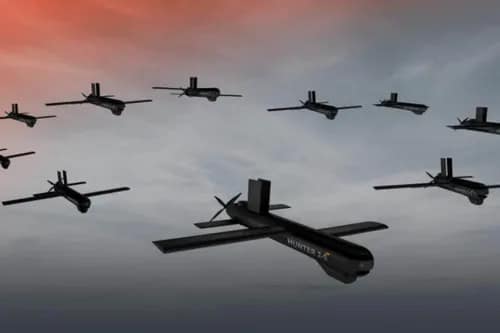PODCAST: Defense One explore several facets of contemporary military technology and strategy. One article highlights L3Harris’s new “Amorphous” drone swarm technology, emphasizing its low-bandwidth communication and high autonomy to allow a single operator to control thousands of drones, a development crucial for future battlefield scenarios with electromagnetic interference. Another piece discusses the persistent software development challenges plaguing the F-35 fighter jet program, particularly with its crucial Technology Refresh-3 upgrade. Finally, the third article examines former President Trump’s ambitious, yet potentially costly and technically challenging, “Iron Dome for America” concept, which envisions a space-based missile defense shield to protect the U.S. homeland.

Drone swarm autonomy refers to the capability of multiple drones to operate collectively and make decisions without direct human control, using algorithms and artificial intelligence to achieve common goals. These swarms leverage concepts like swarm intelligence, mimicking patterns observed in nature, to navigate complex environments, adapt to changing conditions, and perform tasks such as surveillance, reconnaissance, and even attack. [1, 2, 3, 4]
Key aspects of drone swarm autonomy:
- Decentralized control: Instead of relying on a central command, drones in a swarm often operate with distributed control systems, communicating and coordinating with each other in real-time. [2, 2, 4, 4]
- Artificial intelligence (AI) and machine learning (ML): AI and ML algorithms enable drones to learn from their environment, adapt to unexpected situations, and make autonomous decisions, such as avoiding obstacles, optimizing flight paths, and identifying targets. [2, 2, 4, 4]
- Swarm intelligence: This approach involves individual drones following simple rules, which collectively lead to complex and emergent behaviors, similar to how birds or insects operate in a swarm. [2, 2, 3, 3]
- Robustness and resilience: By distributing tasks among multiple drones, swarms can be more resilient to individual drone failures or disruptions, as the remaining drones can continue the mission. [4, 4, 5, 5, 6, 7, 8]
Examples of drone swarm autonomy:
- Military applications: Drone swarms can be used for reconnaissance, surveillance, and even attacks, overwhelming defenses with sheer numbers and performing complex operations with minimal human oversight. [1, 1, 4, 4, 9, 9]
- Disaster relief: Autonomous drone swarms can be deployed to assess damage, map affected areas, and deliver supplies in disaster zones, potentially improving response times and efficiency. [10, 10, 11, 11]
- Commercial applications: Drone swarms are being explored for tasks like package delivery, infrastructure inspection, and search and rescue operations, offering potential for increased efficiency and safety. [3, 3, 12, 12, 13, 14]
Challenges and future directions:
- Developing robust AI and ML algorithms: Ensuring that drones can reliably operate in complex and dynamic environments, including those with GPS jamming or other forms of interference. [2, 2, 15, 15]
- Addressing ethical and legal concerns: Establishing clear guidelines and regulations for the use of autonomous drone swarms, particularly in military applications. [5, 5, 16, 16]
- Human-machine teaming: Finding the optimal balance between human oversight and autonomous operation, ensuring that human operators can intervene when necessary and that AI systems operate within ethical and legal boundaries. [5, 5, 16, 16]
- Continued advancements in drone technology: Further development of drone hardware, including longer flight times, enhanced sensors, and more powerful processing capabilities. [11, 17, 18, 19, 20]
AI responses may include mistakes.
[1] https://www.youtube.com/watch?v=qcobYfdUwXg
[2] https://dsm.forecastinternational.com/2025/01/21/drone-wars-developments-in-drone-swarm-technology/
[3] https://droneii.com/commercial-use-of-drone-swarms
[4] https://www.autonomyglobal.co/drone-swarms-are-coming-the-future-of-autonomous-operations/
[6] https://milvus.io/ai-quick-reference/what-are-the-key-principles-of-swarm-intelligence
[7] https://www.youtube.com/watch?v=e5tJJT375cc
[8] https://www.linkedin.com/pulse/swarm-technology-imet-369-sw7tc
[9] https://www.axios.com/2024/03/15/drone-swarms-ai-military-war
[10] https://www.thedroningcompany.com/blog/autonomous-drone-swarm-navigates-a-bamboo-forest
[11] https://github.com/mnmldb/autonomous-drone-swarm
[13] https://grupooesia.com/en/insight/uas-swarm-operations-key-factors/
[14] https://www.um.edu.mt/library/oar/handle/123456789/115258
[15] https://ieeexplore.ieee.org/document/9990563/
[16] https://sdi.ai/blog/military-drone-swarm-intelligence-explained/
[17] https://www.youtube.com/watch?v=uB29Q0hU6Z8
[19] https://www.youtube.com/watch?v=_Gkx7vxe3OI&pp=0gcJCf0Ao7VqN5tD
[20] https://link.springer.com/chapter/10.1007/978-981-97-8553-7_16
Not all images can be exported from Search.